Ministers are facing mounting calls for the parts of England with the smallest Covid outbreaks to be released from lockdown earlier, with official data showing cases in the worst-hit areas are seven times higher than in others.
Department of Health data showed Devon, Cornwall and the Isle of Wight recorded fewer than 50 infections per 100,000 people in the week ending February 18. For comparison, the figure was 286.6 in Middlesbrough — the nation’s current hotspot.
But under Boris Johnson’s four-stage ‘roadmap’ back to freedom, everyone in England will be forced to move out of lockdown at the same pace and to wait at least five weeks between each change. Ministers have refused to follow Scotland’s path, which will see some areas released sooner than others.
The MP for Exeter, Ben Bradshaw today urged the Prime Minister to ease restrictions faster for areas with the lowest infection rates. ‘The vaccination programme is showing stunning results in preventing serious illness and death,’ he told MailOnline. ‘If this is sustained, it would be perverse to keep local businesses closed for Easter because rates remain high in some other far-flung part of the country.’
He added: ‘Exeter and Devon have among the lowest Covid rates in the country. Our vital hospitality businesses are on their knees. Scotland is adopting regional variations, as it emerges from lockdown, and we haven’t heard a satisfactory explanation from the Government as to why that can’t happen here.’
Selaine Saxby, the MP for North Devon, added her voice to the calls, telling MailOnline the roadmap was going ‘too slowly’ for her area. ‘I think our cases are low and we could have started local unlocking sooner,’ she said, ‘but I also think, for tourism, moving at a national pace is important’.
Dr Gabriel Scally, a member of Independent Sage and former regional director for health for the South West, said the Government should work ‘local flexibility’ into its plans and enact ‘green zones’ allowing life to return to normal in areas where case rates had fallen to single figures.
Instead of easing restrictions on a case-by-case basis in different regions, the Prime Minister’s ‘one-way’ ticket out of lockdown will see schools reopen to all pupils on March 8. The Stay at Home edict could finally be dropped on March 29 and shops, hairdressers and pubs may be allowed to reopen by April 12. The earliest all legal limits on social contact could go is June 21.
Mr Johnson has not ruled out ‘local action’ in reverse, however, which could see tighter curbs brought back in to areas where there are Covid spikes in the future.
The now defunct Tier system — which twice failed to keep England out of lockdown — saw certain areas enjoy months of lighter curbs, with friends and families allowed to meet in restaurants, pubs and cafes.
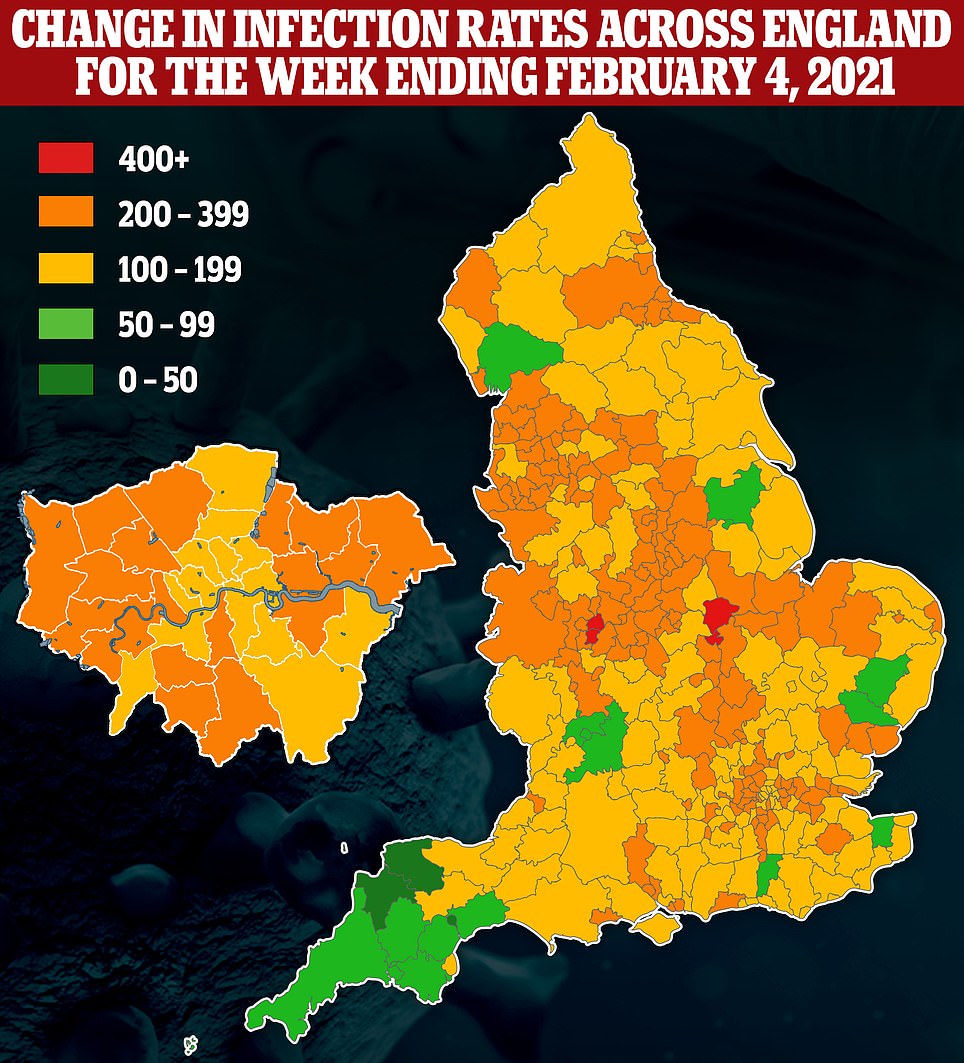
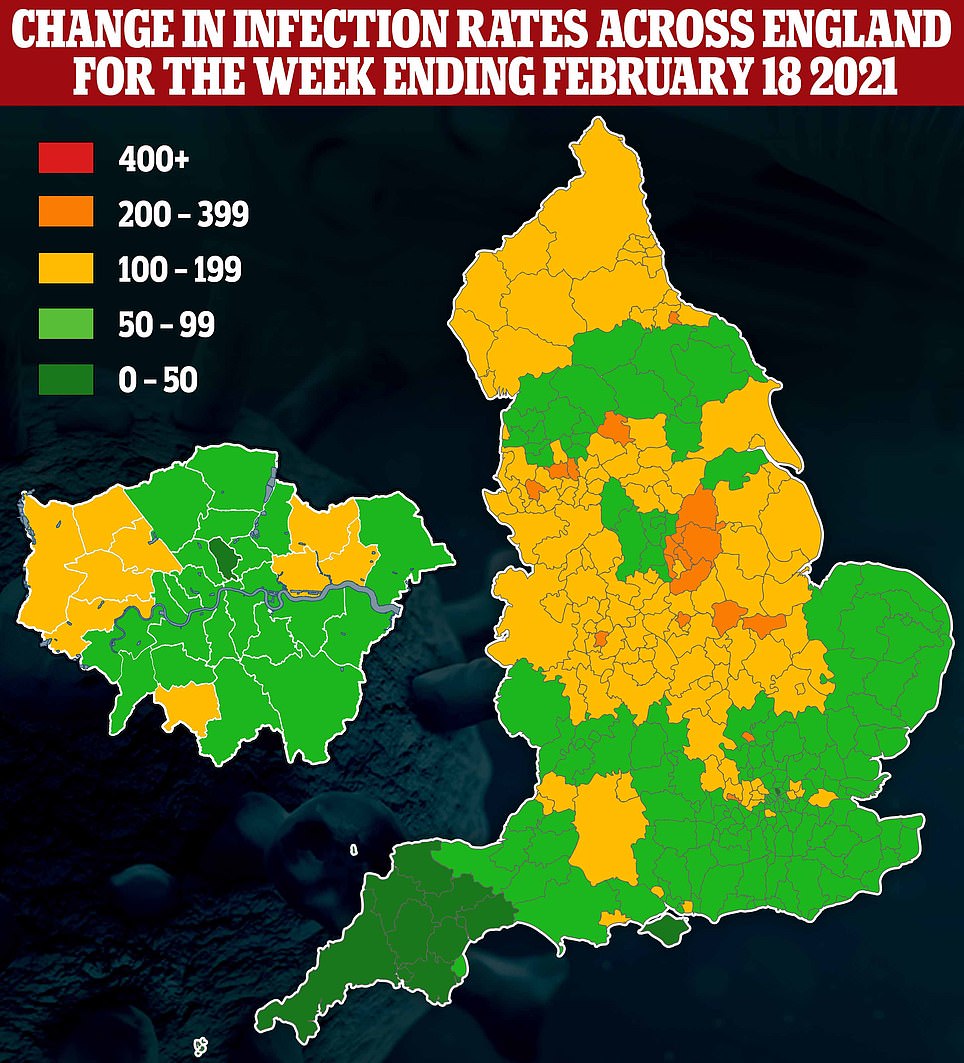 ‹ Slide me ›
‹ Slide me ›
LEFT: Infection rates in week ending February 4. RIGHT: Infection rates in week ending February 18. Public Health England data show that rates of infection are considerably lower in some rural areas such as Devon and Cornwall (dark green indicates the lowest rate), compared to higher numbers of infections in the Midlands
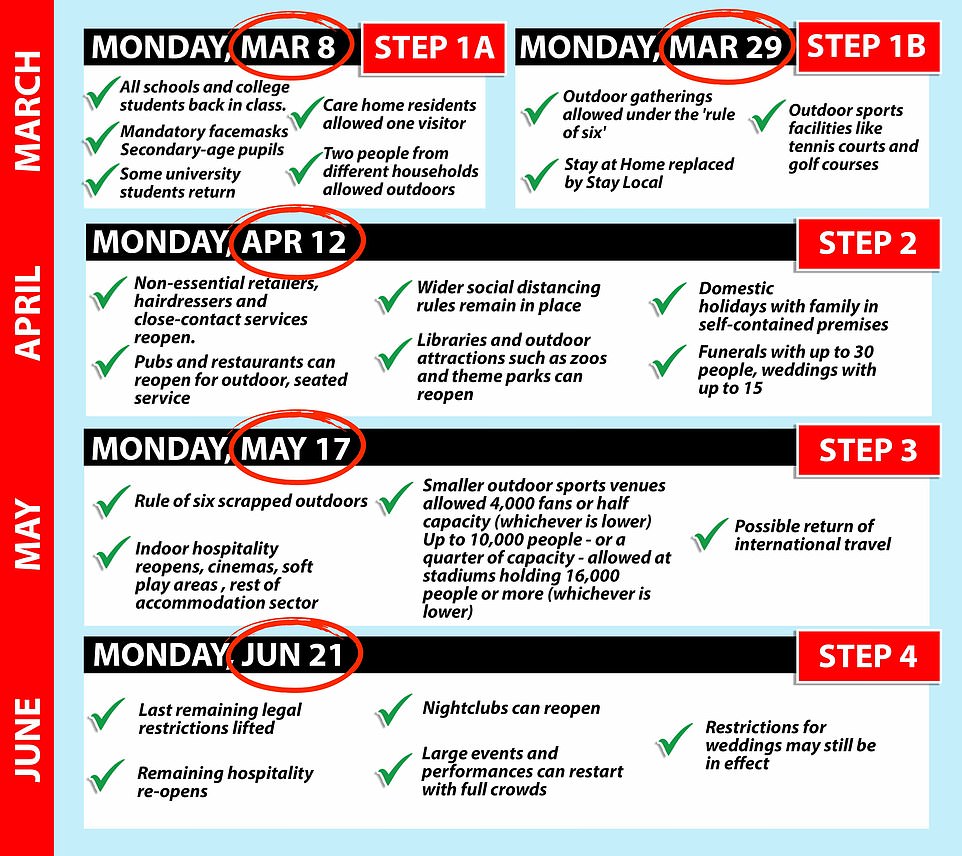
Department of Health data on the weekly coronavirus infection rate up to February 18, the latest available, showed the smallest outbreaks were in the South West and London.
The smallest outbreak was in Islington, London, where the infection rate was just 38.8 cases per 100,000 residents. Officials have previously advised councils in the capital, however, that they should not have different restrictions because they are so closely connected.
WHICH AREAS HAVE THE LOWEST COVID INFECTION RATES?
Council
Islington
Devon
Cornwall
Plymouth
Isle of Wight
Tower Hamlets
Bath,N. Somerset
Gloucestershire
Camden
East Sussex
Brighton, Hove
Infection rate
38.8
39.3
39.7
48.5
49.4
50.2
50.7
52.1
53.3
54
54
% weekly change
-56%
-26%
-44%
+1%
-54%
-42%
-42%
-36%
-30%
-39%
-29%
Source: Department of Health data on infection rates by local authority up to February 18, the latest available. It takes a week to establish the infection rate today because of delays with the testing system and the lag between becoming infected and suffering symptoms.
Advertisement
Devon had the second smallest outbreak in the country after recording 39.3 per 100,000, followed by Cornwall and the Isles of Scilly (39.7) and the Isle of Wight (49.4).
For comparison, the highest infection rate was in Middlesbrough (286.6), followed by Peterborough (270) and Sandwell in the West Midlands (263.1).
Ms Saxby told MailOnline it would be good to see some curbs in Devon dropped earlier. ‘This would be partly so we could get used to seeing each other again,’ she said. ‘It will be a big shock for people.’
Asked how she would react if surging cases elsewhere in the country prevented Devon from moving down the stages, she added: ‘We’ll have to see what happens when we get there, but it is clear this is national to avoid a full lockdown.’
Professor Scally, from the University of Bristol, said there should be ‘local flexibility’ with the restrictions because it was clear the second wave was unequally spread across the country.
‘There should be local flexibility about what is needed to deal with the virus as we do know it isn’t equally distributed and it’s only right local areas should take action if there are outbreaks in their area’, he said.
‘That is going to be more and more necessary as vaccination takes a lot of cases down.
‘I do think there should be flexibility but it is really dependent on the Government building up public health teams on the ground and really improving the Test and Trace system.’
The head of Visit Cornwall, Malcolm Bell, told MailOnline hotels and bed and breakfasts in the county had been hoping they would be allowed to open two to three weeks before the earmarked May 17.
‘I think the challenge we’ve got is unless it is at least a third of the country I don’t want to go back to those silly tiers,’ he said.
‘There is no point in opening up if people cannot come here from their home.
‘We were in Tier One, then Tier Two. When the Tiers were North of Birmingham that wasn’t a problem, but when they came down that was just killing our market.
‘There is no point being open for staying visitors if people can’t actually come.’
He said they were encouraging tourists to make contact with the hotels and B&Bs they wanted to stay in directly to ask about refunds and booking policies. He said some were taking pencil-bookings where they would reserve rooms for certain dates and offer a full refund if restrictions meant the trip couldn’t go ahead.
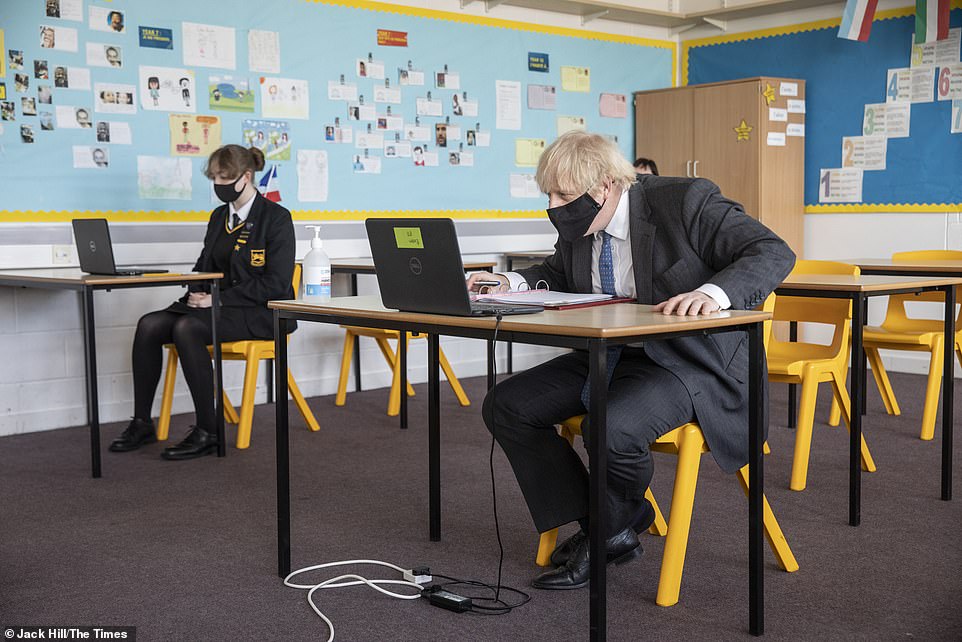
Summer lessons will be offered to children leaving primary school and all secondary pupils as part of a £700million catch-up package designed to reverse the impact of Covid on education. Pictured: Boris Johnson takes part in an online lesson during a visit to Sedgehill School in Lewisham, south east London, on February 23
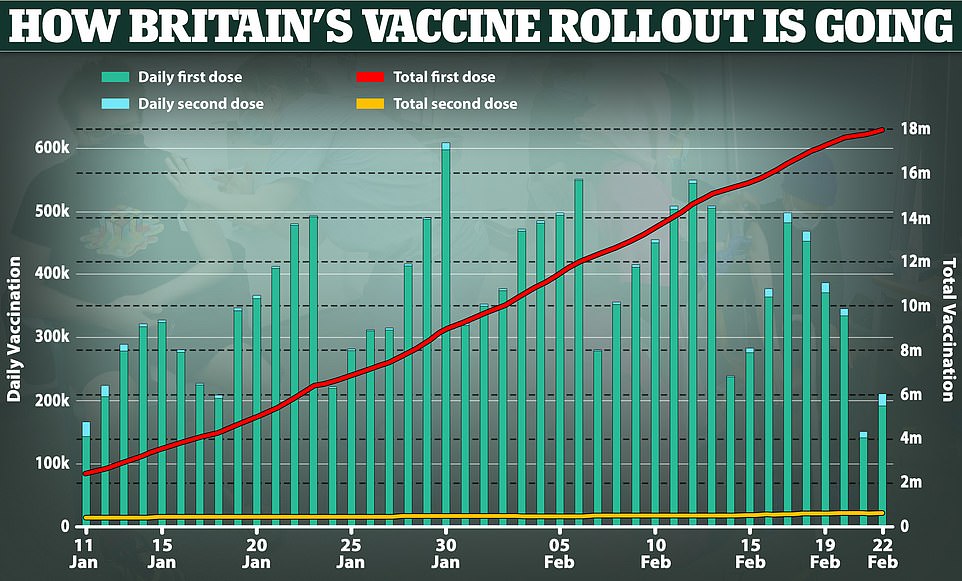
Figures show just 150,000 Covid vaccines jabs were dished out in the UK on Sunday, the worst daily output since the scheme began to pick up pace last month
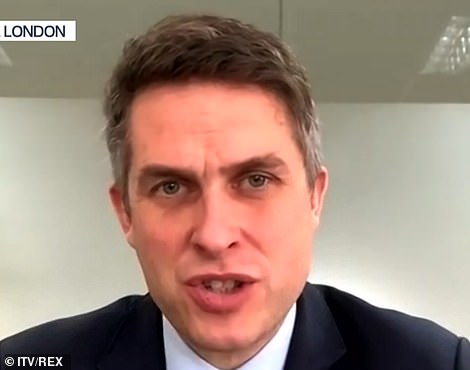
Gavin Williamson today hinted that the school day could be extended alongside summer catch-up classes to recuperate thousands of hours of lost learning inflicted by the pandemic
Announcing the roadmap out of restrictions on Monday in the Commons, Mr Johnson admitted there could be ‘local action’ in areas where cases spike.
He said: ‘Next month we will publish an updated plan for responding to local outbreaks, with a range of measures to address variants of concern, including surge PCR testing and enhanced contact tracing.
‘We can’t, I’m afraid, rule out re-imposing restrictions at local or regional level if [the] evidence suggests they are necessary to contain or suppress a new variant which escapes the vaccines.’
Health Secretary Matt Hancock and Communities Secretary Robert Jenrick have both previously suggested that extra local restrictions may be brought back in some areas should infections spike.
Vaccines Minister Nadhim Zahawi has, however, warned England will be moving down restrictions at the same pace because infections were at ‘similar’ levels. ‘So the view is very much that this is about a gradual reopening of the whole of England, not regional,’ he said. WHEN?
Dr Mike Tildesley, a statistician on Sage, also hinted yesterday that some further restrictions could be imposed on areas where infections begin to spike.
‘If we do see a spike in cases or if we see things not going down as fast as we hoped I think there needs to remain the possibility to hold off for a couple of weeks so we get things in control,’ he told BBC Radio 4’s Today programme.
‘[This is] particularly if the government wants to have this one-way route to freedom which I think in itself is potentially a little bit uncertain.
‘It may well be that we have to have some measures introduced for a little bit of time in order to prevent these surges in infection occurring so that ultimately we can take virtually a one-way route back to normality.’
It comes as Gavin Williamson today hinted that the school day could be extended alongside summer catch-up classes as part of a £700million package to recover lost learning time after the pandemic.
The Education Secretary confirmed the government is looking at a ‘broad range of options’ when asked if school hours could be increased to make up for lost time during lockdowns.
Under plans announced today, secondaries will offer face-to-face teaching over the holidays, with ministers keen to see summer classes for incoming Year 7 pupils.
The summer schools will be funded with £200million from the package, while a £302million Recovery Premium will also see every primary school handed £6,000 and secondaries £22,000 each to fund further support for pupils most in need.
The Department for Education said this will come on top of another £200million in funding for the National Tutoring Programme and other tuition schemes and could be spent on extra clubs, activities or teaching for those who have fallen behind.
However, other radical measures like permanently trimming the summer holidays or lengthening the school day do not figure in the plans yet.
Experts warned that the package is only a ‘start’ and it could take a decade to heal the ‘educational scarring’ suffered by children during the crisis.
Source link : https://www.dailymail.co.uk/news/article-9294079/Covid-outbreaks-SEVEN-TIMES-smaller-areas.html











